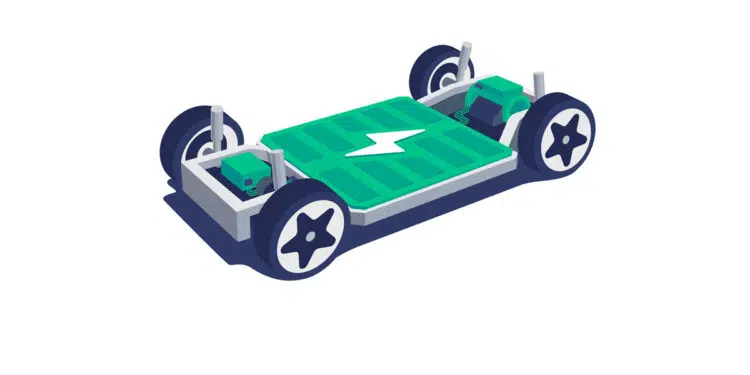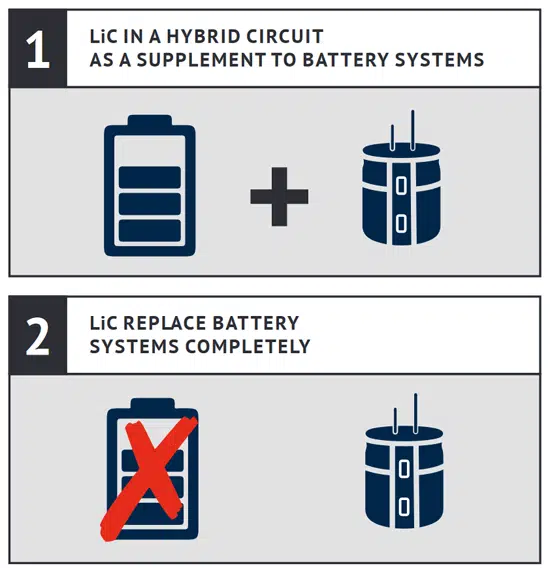For electrically powered automotive vehicles, energy storage is one of the biggest challenges. Can supercapacitors become a sustainable alternative to batteries in electrical vehicles ?
This technical memo written by Alexander Schedlock, Jianghai Europe Electronic Components GmbH discusses use of hybrid lithium-ion capacitors (LiC) supercapacitor-battery energy storage systems for electrical cars.
For electrically powered vehicles, energy storage is one of the biggest challenges.
Jianghai has been manufacturing lithium-ion capacitors (LiC) from the Energy-C family for years, which are increasingly being used for e-mobility in two different concepts:
- LiC IN A HYBRID CIRCUIT AS A SUPPLEMENT TO BATTERY SYSTEMS
- LiC REPLACE BATTERY SYSTEMS COMPLETELY
While in the first concept the properties of the high number of cycles and fast charging of LiC are primarily used (e.g., for energy recuperation when braking, support during acceleration) and thus helps to reduce the size of the heavy and large battery and to support it electrically, the second concept will be presented here:
The development goals for electric vehicles are largely similar to the requirements for vehicles with combustion engines:
long range and fast charging are so much in focus that the ecological benefits run the risk of getting lost. Concessions to the technology require the necessary thermal management for the battery, the losses of the battery charging system and the relatively low charge and discharge cycle number of batteries available today. The size and weight of the batteries, their ecologically questionable production including the use of rare raw materials
and the risk of fire in the event of destruction or malfunction are unfavorable.
THE ADVANTAGES OF LIC ARE OBVIOUS HERE:
- Energy storage in an electric field rather than chemical reactions inside a battery
- Up to 500,000 charge and discharge cycles
- Significantly higher power density
- Intrinsic safety: Even in the event of mechanical damage, electrical overload or operation at over- or low temperatures, there is no risk of fire
- Doping with lithium ions conserves resources and solves the supply problem with the valuable raw material lithium
- Very high charge and discharge currents due to low loss electrolytes and electrodes
- Weight reduction: a halving of the mass compared to a battery of the same volume is possible
- Charging times in the minute range
EXAMPLE
A closer look at the development goals of electric cars reveals that high ranges rarely occur in practice in the everyday operation of many vehicles. Statistically, most (small) vehicles drive a maximum of 25 km to work or cover only approximately the same distance for purposes such as shopping, school and kindergarten trips1.
Let‘s illustrate this with the example of a common 75 kWh battery with dimensions L x W x H = 2670 mm * 1540 mm * 150mm. A single cell package of this battery has dimensions L x W x H = 69 mm * 31 mm * 80 mm with a capacity of 5.2 kWh. In addition, there is the volume of the necessary electronics for balancing, charge management, safety and thermal monitoring.
For simplicity, however, here we consider only a single cell package without control and monitoring. In the same volume, 32 cells of a lithium-ion capacitor (LiC) from Jianghai could be placed (series HAA, e.g. 16,000 F) including the mounting frames. The storable energy is 693 Wh. This amount of energy corresponds to about 15% of the energy stored in the battery cell package.
If we assume the range of a battery-powered vehicle at 580 km, a vehicle designed with capacitors would only achieve around 15% of the range: ~80 km (with a single charge). This range is more than sufficient for a variety of applications. With existing charging stations, a recharge would be possible within minutes, a shorter time than a purchase in the supermarket.
The road block lies in the acceptance of the alternative usage concept. Electric vehicles based only on capacitors are not an alternative for long-distance applications. However, these are today‘s battery-powered vehicles on honest view only to a limited extent.
CONCLUSION
Jianghai sees two important, different usage concepts with two different marketing strategies. The capacitor technology opens up the opportunity for very cost-effective and environmentally friendly second cars for short distances, at the latest when the battery vehicles have to be put under discussion in the view of increasing environmental and sustainability requirements. The hybrid solution helps long-distance vehicles to save energy and to extend their range.
With regard to Europe, it should be noted that the technology presented here is already in use in China.
1 https://www.destatis.de/DE/Themen/Arbeit/Arbeitsmarkt/Erwerbstaetigkeit/Tabellen/pendler1.html



































